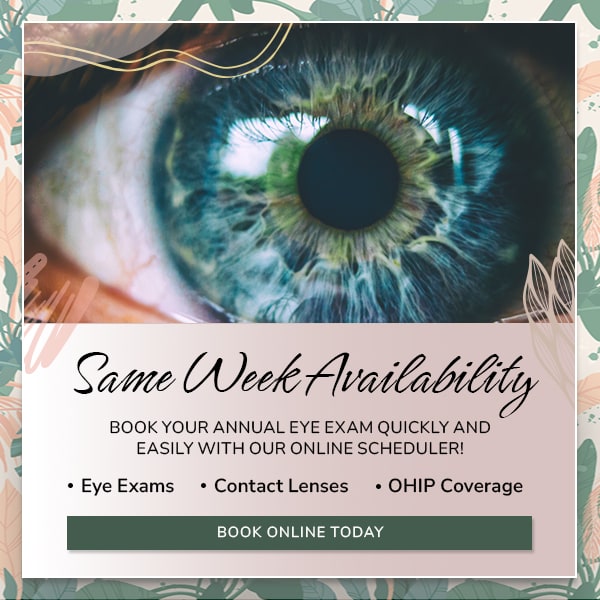You’ve likely heard the news that as of September 1st, 2023, there will be changes to your OHIP-insured eye coverage.
The Ministry of Health and Ontario Association of Optometrists agreed that optometric services should emphasize coverage for those with sight-threatening conditions. A lot of the changes you will see have this concept in mind and focus on keeping care for those most vulnerable to impaired vision.
So, what are the changes? First, let’s go over what was covered before September 1st
Firstly, OHIP coverage is categorized by age group. There are three groups:
- Children 0-19 years old
- Adults 20-64 years old
- Seniors 65 years and older
Children 0-19:
Children aged 0 to 19 years were eligible for one “major oculo-visual examination” every twelve months. They were also eligible for one “minor oculo-visual examination” per day within that twelve-month period between major exams. Meaning, they had unlimited partial exams between their full exams. There was no limitation to children getting their eyes checked and did not need an “eligible medical condition” to be covered. So, if your child’s eyes were healthy and they had no medical conditions, they were still covered annually and were able to come in for as many “minor” or partial exams as needed.
Adults 20-64:
Healthy adults between the ages of twenty and sixty-four years old were not funded by OHIP for their major oculo-visual examinations. Examinations for these individuals were self-paid. Private insurance obtained through employers’ benefits typically covers a portion or percentage of the service fee every 24 months. The coverage from this type of insurance is set by the patient’s employer.
Adults 20-64 with specific ocular or health conditions
- Individuals who presented with the following were covered for a major ocular health examination once every twelve months:
- Diagnosed glaucoma
- Diagnosed with diabetes and taking medication
- Cataracts impairing vision
- Retinal conditions, such as macular degeneration, macular scarring
- Optic pathway diseases, meaning a stroke or tumor that affected the visual field
- Amblyopia
- Corneal diseases, such as keratoconus
- strabismus
- Recurrent uveitis
Seniors 65+:
Seniors aged 65 and older were eligible to get a Major Oculo-visual Examination once every 12 months, and a Minor Oculo-visual Examination once per day within the twelve-month period. There was no limitation to the number of minor exams they could come in for. Their ocular and health status was also independent of their coverage – if they were 65 and older, they could come in once per year for their full exam.
So, what’s changed?
Children 0-19:
Nothing has really changed regarding children’s coverage. They are still eligible to come in once every twelve months for an eye exam and they have unlimited partial or “minor” examinations.
Adults 20-64:
Adults aged 20-64 are still separated into two groups: with eligible medical conditions and without eligible medical conditions. Healthy adults without eligible medical conditions may still use their insurance benefits to cover their eye exam (usually every twenty-four months). Adults with eligible medical conditions that were covered before September 1st need to pay close attention to the changes as their condition may have been de-listed.
The current eligible medical conditions are as follows (cited from Ministry of Health’s Schedule of Benefits for Optometry):
- Glaucoma requiring or having had treatment with medication, laser (excluding prophylactic laser peripheral iridotomy), or surgery;
- Cataracts / posterior capsular opacification with a visual acuity of 20/40 or worse in the best corrected eye, or when a surgery referral is made;
- Retinal disease that is acute, or chronically progressive;
- Corneal disease that is acute, or chronically progressive;
- Uveitis that is acute or chronic during episodes of active inflammation;
- Optic pathway disease that is acute, or chronically progressive;
- Acquired cranial nerve palsy resulting in strabismus during the acute phase or until the condition resolves or stabilizes;
- Ocular drug toxicity screening for patients taking hydroxychloroquine, chloroquine, ethambutol or tamoxifen;
- Diabetes mellitus.
Understanding the wording:
See how a lot of those conditions say “acute, or chronically progressive?” That means that the condition can only be billed to OHIP if it’s new or sudden, or if it is a condition that is known to be progressive in nature (gets worse with time). So, conditions like retinal scars, corneal scars, keratoconus that are stable are no longer covered.
Cataracts: an important change in coverage for patients developing cataracts is the vision requirement. For this condition to be covered by OHIP, vision must be 20/40 or worse in the BETTER eye. Meaning, that if you have one eye that sees really well and one eye that is developing a cataract, the exam most likely will not be covered. The exception is if the optometrist recommends a referral to a specialist for surgical consultation.
Expanding more on the concept of focusing coverage on conditions that are acute or chronically progressive, amblyopia and strabismus are no longer covered. Both of these conditions are known to be stable in adulthood, and as a result, are no longer covered for patients between the ages of twenty and sixty-four.
Ocular Toxicity Monitoring:
One exciting change is that patients on certain medications like tamoxifen, chloroquine, hydroxychloroquine, and ethambutol will now have coverage for annual examinations. This is because these drugs may cause toxic changes to the retina and impair vision the longer a patient takes them.
Seniors 65+:
Whereas before September 1st anyone sixty-five and older was eligible once per year for an eye examination, seniors are now divided into two groups:
- With eligible medical conditions
- Without eligible medical conditions.
The “eligible medical conditions” are the same as outlined above.
Seniors WITH eligible medical conditions are covered once every twelve months for a Full (Major) Eye Exam, and two Partial (Minor) Eye Exams within the twelve-month period.
Seniors WITHOUT eligible medical conditions are covered once every eighteen months for a Full (Major) Eye Exam, and two Partial (Minor) Eye Exams within the eighteen-month period.
This means that seniors are no longer able to come for unlimited partial exams. For this reason, we recommend coming for a partial exam only when necessary. Visits beyond the allotted partial exams are not covered under OHIP and will be charged as self-pay.
We hope this breakdown helps with any confusion you may have. If you have any questions, please give us a call at (416) 434-2867 or email us at [email protected].


